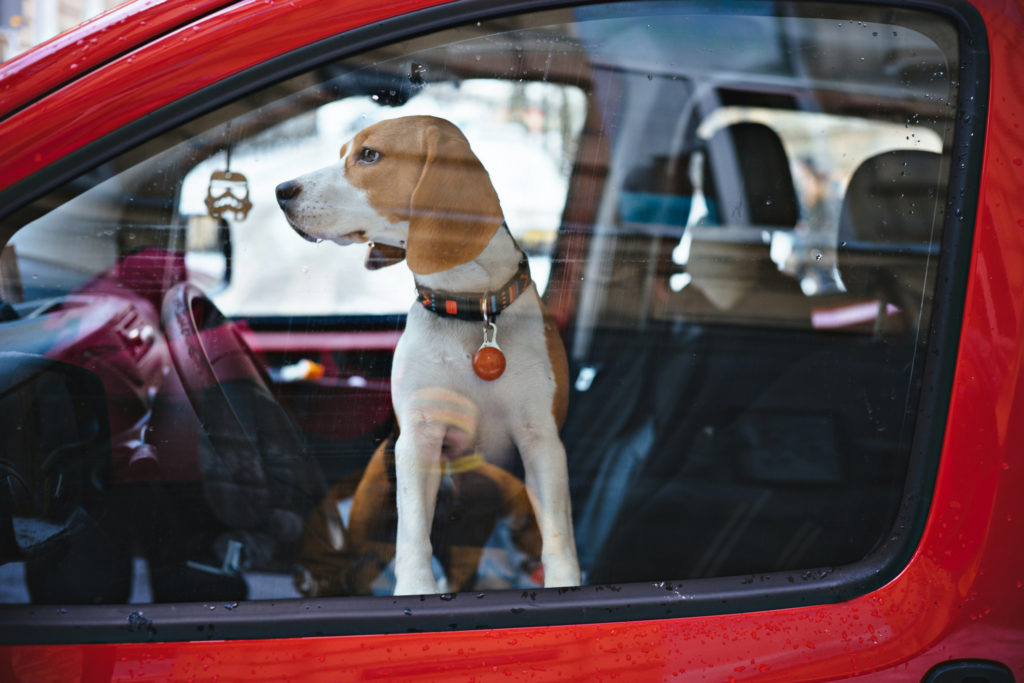With the summer in full swing, one of the more common emergencies seen by the Urgent Care service at Friendship Hospital for Animals is heat stroke. Heat stroke is an illness that develops when the body temperature rises to dangerous levels. This increased temperature has effects on the entire body—it can cause shock, difficulty breathing, damage to the brain and kidneys, bleeding, and GI upset. If not treated promptly, and in severe cases, it can be fatal.
It’s important to know that heat stroke can occur at any time of the year and to any patient. However, heat stroke is more common in dogs and in the summer months. It can either be classified as exertional (which occurs with exercising during hot and humid weather) or nonexertional (with the classic example being of an animal trapped in a hot car).

What causes heat stroke?
- Heat stroke occurs when the body cannot get rid of excess heat. The heat can be generated by exercise, come from the environment, or created by metabolic conditions (example: prolonged seizure activity).
- Exertional heat stroke can occur when animals are exercising when it is hot or humid. Even a normal walk can turn into a life-threatening emergency. Brachycephalic animals (such as Pugs, Boston Terriers, Bulldogs) are at higher risk of heat stroke as are animals with respiratory diseases like laryngeal paralysis.
- Nonexertional heat stroke occurs when animals are restricted to a confined area with minimal airflow, such as a parked car. The temperature in a parked car- even with the windows open- can rise rapidly. The combination of high temperatures, poor ventilation, and having a fur coat, can cause animals to overheat.
What are signs of heat stroke
Signs of heat stroke can include:
- Weakness or collapse
- Pale gums
- Noisy or raspy breathing (particularly in brachycephalic dogs)
- Excessive panting, including panting that persists long after ceasing exercise or moving to a cool environment
- Dull or depressed mentation- i.e. if your pet does not respond to you as they normally would
What should I do if I think my animal is experiencing heat stroke?
- Stop any activity that your animal is involved in
- It outdoors, move indoors to an air-conditioned area, an area with fans, or into an air-conditioned car
- Cool you pet by placing a soaked towel over their body or hosing their body with cool water.
- Do NOT place your animal in a tub or ice bath. Animals that are weak could drown if left unattended. Water that is too cold can actually impair heat loss.
- If your pet is showing the listed signs above AND has been outside in hot or humid weather OR has been confined to a car or other small space, bring them to a veterinarian immediately!
How can I avoid heat stroke?
- Talk to your veterinarian about whether or not your pet is at increased risk of heat stroke.
- Be aware of the temperature, humidity, and air quality when planning outdoor activities or trips with your pet.
- Avoid exercising during the hottest parts of the day; try to plan walks and time outdoors for the early morning and late evening hours. Limit exercise to short periods of time. Alternatively, spend play time indoors in an air-conditioned environment.
- Keep your pet at home when it’s hot! As much fun as it is to bring your pet for a car ride, do not bring them on car trips unless they can be kept in an air-conditioned car at all times.
Take away points
- Heat stroke can occur when the body temperature rises to dangerous levels.
- Animals are at risk of heat stroke if they are exercising when the weather is hot or humid or if they are confined to a space with poor ventilation.
- Know if your animal has a higher risk of heat stroke (i.e. if you have a brachycephalic dog or a dog with respiratory disease). Know the signs of heat stroke.
- If you think your pet is experiencing heat stroke, stop any activity, cool them, and transport them to a vet immediately.
Dr. Maggie Thies grew up in Maryland but over the course of her education lived in Ohio, Minnesota, Washington, and Massachusetts. Dr. Thies attended veterinary school at the University of Minnesota before completing a rotating internship at the Veterinary Specialty Center of Seattle, followed by an emergency and critical care internship at Massachusetts Veterinary Referral Hospital and a residency at Angell Animal Medical Center. Dr Thies joining the Emergency and Critical Care team at Friendship in 2019.

